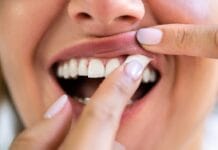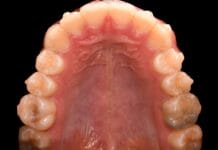A friend recently reached out to me and other dental professionals on Facebook to ask for help regarding a soft tissue injury sustained while his dental hygienist was using an air polisher. We’ll just refer to this fellow as Joe to protect his privacy. Joe has seemingly suffered every complication and long-term side effect from treatment for head-and-neck cancer that was diagnosed in 2003. As a result, he has very fragile health, as do most head and neck cancer survivors.
Joe is extremely intelligent and has done as much research to improve his quality of life as most oncology physicians have done. He has developed a stringent nutrition and exercise program for himself that has extended his life far beyond the expectations of his doctors. He is well aware of his increased risk for dental caries due to his reduced salivary function and his increased risk of periodontal disease due to his impaired immune function. As a result, he is impeccable with his self-care, and faithfully has routine preventive maintenance procedures every three months.
Joe recently moved to a new city. He was having a prophylaxis, and his new hygienist was using an air polisher, a device that was unfamiliar to him. Air polishing involves the use of compressed air, water, and glycine (or sodium bicarbonate) powder to disrupt oral biofilm and remove stain from tooth surfaces. Air polishing requires careful angulation to avoid trauma to oral soft tissues. Each manufacturer publishes guidelines regarding the safe use of the device, and thousands of dental patients are treated with this technology without injury every year.1
Joe was injured by the misuse of the air polisher. His case is uncommon but known in the research literature. He states that he felt the polisher spray move from the lower left teeth towards the lower right where he felt “a sharp stabbing” in the tissues on the floor of his mouth. Suddenly, he experienced excruciating pain in the floor of his mouth and the base of his tongue on the right side.
He later compared the jolt of pain to that of “having a root canal without anesthesia.” The tissues on the floor of his mouth began to bleed, his right buccal mucosa instantly “swelled up like a balloon,” and he felt a crackling sensation in his right cheek and his right ear. He lost sensation in the right temporomandibular joint, the entire right side of the floor of his mouth and the base of his tongue. Joe developed swelling of the submandibular lymph glands, his sinuses immediately became congested, his voice tone changed, and his hearing became diminished in his right ear.
Instantly, Joe began to perform lymphatic drainage techniques on his cheek to reduce the swelling. He was concerned that the air or water that he felt was forced into his tissues would travel to his lymphatic system or vascular system and possibly cause a fatal air embolism. This is evidence of Joe’s deep knowledge of anatomy and physiology.
Joe managed to achieve some reduction in swelling, but the pain persisted. Joe stated that the dentist initially attributed the bleeding to Joe’s blood thinners and seemed at a loss to explain the dramatic reactions to the air polishing injury. Joe went home with all of the above symptoms and severe pain that persisted for the next several hours.
What Sparked Painful Reaction?
The dentist called Joe that evening to check on him, and the doctor referred Joe to Emory University for a follow-up. The otolaryngologists diagnosed Joe with parotitis, an inflammation of the parotid gland. They did not say what had preceded or caused the parotitis.
I believe, given the symptoms, that the inflammation in the parotid gland was caused by a condition called subcutaneous emphysema, which was the result of the invasion of compressed air into the oral soft tissues.2
Subcutaneous emphysema is a rare condition that results when air is forcefully introduced under the soft tissues through disrupted intraoral barriers during dental procedures such as air polishing or air abrasion.3
Oral cancer survivors may experience subcutaneous emphysema and other traumatic injury because radiation therapy causes oral tissues to become extremely fragile.3,4 Head-and-neck radiation treatment may also destroy the lymphatic system, making it ineffective at clearing contaminants, such as air, water, and the glycine or sodium bicarbonate particles used in air polishing that could be forced into the interstitial tissues. The impaired immune system may also be unable to combat bacteria or other microorganisms that may be projected into the tissues and lead to infections.5
Some people are in such fragile health that simply blowing air from the air/water syringe could cause subcutaneous emphysema. Examples in scientific literature point to people who are otherwise perfectly healthy and have absolutely no pre-existing frailties or health complications and yet experience subcutaneous emphysema as well.6
Symptoms and Signs
Extreme care must be taken to review every patient’s health history prior to any patient treatment. Head-and-neck cancer survivors require even more extreme caution before choosing to perform any procedure or utilize any technique or technology that could endanger the patient. We take for granted that an air polisher is a very helpful piece of equipment that allows for efficient disruption of oral biofilm and surface stains. But how often do we consider the risk to which we are exposing our patients if we happen to traumatize the oral mucosa and allow forced air, water, and particles to enter the body?
While rare, there have been several documented cases of subcutaneous, cervicofacial, and retropharyngeal emphysemas attributed to iatrogenic injury from the use of air-polishing and air-abrasive devices in the dental office. Other possible sequelae include pneumothorax, cerebral air embolism, mediastinal emphysema, pneumomediastinum, and thrombosis.
The symptoms of subcutaneous emphysemas are sudden facial swelling, a crackling sensation in the face and neck area, crepitus in the temporomandibular joint and ear, tenderness, and pain.
Additional symptoms can occur with spread of the air into the tissues, including difficulty breathing, swelling of the eyes, loss of vision, loss of hearing, and infection resulting from introducing bacteria or other microorganisms into the deeper tissues.
More serious problems such as thrombosis and fatal embolism can result if the condition spreads and is not treated quickly.7
There are also case reports of this condition being caused by endodontic treatment, surgical extractions, restorative therapy, crown preparations, accidents with sodium hypochlorite, the use of air-driven syringes, and misuse of or failure to use rubber dams.
Patients with pre-existing periodontal disease seem to be more at risk. Subcutaneous emphysemas can also be caused by the patient in post-surgical cases where the person begins to smoke, cough, vomit, or forcefully exhale before healing has occurred.
While rare, subcutaneous emphysema secondary to dental procedures can be extremely damaging and even life-threatening. Entrapped air can travel deeper into the soft tissue and cause a fatal air embolism or dangerous infections through dissemination of bacteria and other microorganisms. Additionally, patients may have minimal or delayed signs or symptoms, making diagnosis and treatment more difficult.
Differential Diagnosis
It may be challenging to make the initial diagnosis of subcutaneous emphysema because many other conditions are associated with rapid swelling, including soft tissue infection, angioedema, allergic reaction, and hematoma. Review the patient’s medical history for any known allergies and any conditions that would cause the patient to be immunocompromised and thus at risk for infection, such as uncontrolled diabetes or human immunodeficiency virus (HIV).8
Usually, subcutaneous emphysema is not associated with erythema and heat upon palpation as seen in skin and odontogenic infections.9 If the cardinal signs of infection are present (heat, redness, swelling, pain), the diagnosis would likely not be subcutaneous emphysema.
Signs that can guide the dental professional to the proper diagnosis include swelling and the pathognomonic sign of crepitus or a crinkling feeling under the skin.
Preventive Strategies
The best management is to avoid the situation entirely. This means conducting a thorough review of each patient’s health history prior to any dental treatment, regardless of how routine or simple the clinician believes that treatment to be. Additionally, manufacturer instructions must be followed closely when using any kind of air-polishing or air abrasion device. Similarly, caution must be taken when using an air/water syringe not to direct the flow of air directly into the tissues.10
Patients must also be cautioned about the increased health risks that could occur with actions that increase intraoral pressure following surgical dental treatment, such as smoking, coughing, and the use of a straw.11
Another way to minimize the risk of subcutaneous emphysema is to ensure that the patient’s periodontal health is optimal.12 Chronic inflammation leads to the formation of deep, ulcerated periodontal pockets and the junctional epithelium becomes compromised, separating from the gingival sulcus. This may create channels for air to spread to adjacent soft tissues when a compressed air device such as an air polisher or a high-speed, air-driven handpiece is used in the area.
It may be prudent to use a rubber dam for protection of the soft tissues while using air polishing on any patient with fragile or compromised health. A simpler solution may be to choose to use a rubber cup polisher instead of a forced air device for those patients.
Contraindications to Air Polishing 13
- Patients on sodium–restricted diet and those with hypertension, although research shows that the amount of sodium bicarbonate ingested during air polishing is not sufficient to cause an increase in blood pressure or blood levels of sodium or alkalosis
- Patients who have respiratory problems such as chronic obstructive pulmonary disease or any condition that interferes with breathing or swallowing. Many head and neck cancer patients fit into this category
- Patients who are immunocompromised, such as those with end-stage renal disease, uncontrolled diabetes, HIV, Addison’s disease or Cushing’s disease
- Patients who have history of head and neck radiation treatment
- Patients who have communicable infections
Technique
Standard infection control procedures should be employed, including the use of protective eyewear for both patient and provider. A pre-procedural rinse should be used to reduce microbial load in ensuing aerosols. Clinicians should wear a high filtration face mask.14
Management and Treatment
If subcutaneous emphysema is suspected:
- Immediately stop the procedure.
- Perform a differential diagnosis to discover if the symptoms are due to subcutaneous emphysema or other condition such as allergy.
- Determine the extent and location of the emphysema by palpation of the skin over the affected area.
- Observe the patient to be sure there are no compromises in the airway, cardiac function, brain function, or vision.
- Some clinicians recommend the administration of prophylactic antibiotics to prevent potential infections and/or corticosteroids to reduce swelling. 15 There is no consensus in the literature on the use of those pharmaceuticals. Natural products are available that could minimize pharmaceutical exposure while providing relief to the patient.
Now Listen to the Today’s RDH Dental Hygiene Podcast Below:
References
- Barnes C. An In-Depth Look at Air Polishing. University of Nebraska-Lincoln. Faculty Publications College of Dentistry. https://digitalcommons.unl.edu/cgi/viewcontent.cgi?article=1013&context=dentistryfacpub
- Lee S.T., Subu M.G., Kwon T.G. (2008) Emphysema following air-powder abrasive treatment for peri-implantitis. Maxillofac Plast Reconstr Surg. 2018;40(1):12. Published 2018 May 13. doi:10.1186/s40902-018-0151-7
- Lee S.T., Subu M.G., Kwon T.G. (2018) Emphysema following air-powder abrasive treatment for peri-implantitis. Maxillofac Plast Reconstr Surg. 2018;40(1):12. Published 2018 May 13. doi:10.1186/s40902-018-0151-7
- Samim F., Epstein J., Zumsteg Z., Ho A., Barasch A. (2016) Oral and dental health in head and neck cancer survivors. Samim et al. Cancers of the Head and Neck. (2016) 1:14. DOI 10.1186/s41199-016-0015-8 https://cancersheadneck.biomedcentral.com/track/pdf/10.1186/s41199-016-0015-8 Accessed June 21, 2019.
- Beech, N., Robinson, S, Porceddu, S., Batstone, M. (2014). Dental management of patients irradiated for head and neck cancer. Australian dental journal. 59. 10.1111/adj.12134.
- Alonso, V., et al. Subcutaneous emphysema related to air-powder tooth polishing: a report of three cases. Asut Dent J.Dec 2017; 62(4):510-515. Doi: 10.111/adi.12537. Epup 2017 July 16.
- Lee S.T., Subu M.G., Kwon T.G. Emphysema following air-powder abrasive treatment for peri-implantitis. Maxillofac Plast Reconstr Surg. 2018;40(1):12. Published 2018 May 13. doi:10.1186/s40902-018-0151-7.
- Wong P., Palacios S., Kashtwari D. Managing Subcutaneous Emphysema Following Dental Procedures August 25, 2017. https://decisionsindentistry.com/article/managing-subcutaneous-emphysema-following-dental-procedures/ Accessed June 21, 2019.
- Wong P., Palacios S., Kashtwari D. Managing Subcutaneous Emphysema Following Dental Procedures August 25, 2017. https://decisionsindentistry.com/article/managing-subcutaneous-emphysema-following-dental-procedures/ Accessed June 21, 2019.
- Lee S.T., Subu M.G., Kwon T.G. Emphysema following air-powder abrasive treatment for peri-implantitis. Maxillofac Plast Reconstr Surg. 2018;40(1):12. Published 2018 May 13. doi:10.1186/s40902-018-0151-7
- McKenzie W.S., Rosenberg M. (2009) Iatrogenic subcutaneous emphysema of dental and surgical origin: a literature review. J Oral Maxillofac Surg. 2009 Jun; 67(6):1265-8. Doi: 10.1016/,.joms.2008. 12.050.
- Wong P., Palacios S., Kashtwari D. Managing Subcutaneous Emphysema Following Dental Procedures August 25, 2017. https://decisionsindentistry.com/article/managing-subcutaneous-emphysema-following-dental-procedures/ Accessed June 21, 2019.
- Barnes C. An In-Depth Look at Air Polishing. University of Nebraska-Lincoln. Faculty Publications College of Dentistry. https://digitalcommons.unl.edu/cgi/viewcontent.cgi?article=1013&context=dentistryfacpub
- Barnes C. An In-Depth Look at Air Polishing. University of Nebraska-Lincoln. Faculty Publications College of Dentistry. https://digitalcommons.unl.edu/cgi/viewcontent.cgi?article=1013&context=dentistryfacpub
- Wong P., Palacios S., Kashtwari D. Managing Subcutaneous Emphysema Following Dental Procedures August 25, 2017. https://decisionsindentistry.com/article/managing-subcutaneous-emphysema-following-dental-procedures/ Accessed June 21, 2019.












